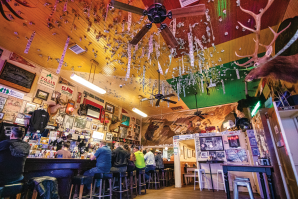When seasonal and climate change-related issues arise, like rolling blackouts, they can impact productivity. While this has long been the case, it plays a little differently now that employees are geographically dispersed by virtue of working from their individual homes. Much of America’s workforce — even customer service-related careers — perform their work remotely these days and, according to Business Insider, a large percentage of them would like to stick with it. Business Insider reports 41 percent of remote workers never want to go back to the office — up from 29 percent in January.
The not-so-new model has many benefits for employers and employees alike, but what’s a company to do when work is interrupted by a power outage? Evil HR Lady comes to us with all the nuanced know-how, advising on the legalities and the policies that could help prevent uncertainty if or when these power-related calamities strike.
Here’s the latest Capital Region Rundown:
Comstock’s contributor Ed Goldman sits down with a local legend at an iconic lunch spot for a special conversation about his past and present career; the new owners of a historic bar maintain its decor and somewhat controversial name; a Grammy-nominated electronic producer plays an outdoor show in Midtown Sacramento; an employer writes Evil HR Lady about power outages’ impact on remote employees; and a local CEO finds stability amid his job’s complexity by building a healthy daily ritual.
Recommendations from our editors:
In this section we editors share what we’re reading, listening to, watching or even eating. Here’s what we’re consuming this week:
Vanessa: Last week I ventured off the Midtown grid to a North Natomas strip mall to try Himalaya Vegan Organic Restaurant. It’s owned and run by a former Tibetan monk who previously worked at his uncle’s popular Oakland restaurant, Shangri-La, the Sacramento Bee reports.
Like Shangri-La, Himalaya serves one dish per meal, and switches it up twice a day for lunch and dinner. My dinner plate was a macrobiotic medley of cooked collard greens, rice, a substantial stew of lentils and salad drizzled with a bright, zingy dressing. The highlights for me were the meal’s book ends — the kidney-bean-and-veggie soup that came with it, and the impossibly fresh and clean-tasting strawberry key lime pie I added on.
Judy: The New York Times writes about the wonders of California’s farmers markets with a spotlight on Sacramento’s Saturday Midtown Farmers Market.
Jennifer: One of the best things about living in the Capital Region is being able to eat according to the seasons — citrus in the winter, stone fruit now, the best tomatoes I’ve ever had in a few months. In the classic cookbook/memoir “Honey From a Weed” by Patience Gray, I’m enjoying reading about another region where food depends on the seasons: the Mediterranean swaths of Italy, Greece, Spain and France. One of my favorite recipes is for spaghetti with (very good) ricotta, which starts with an order to “eat half the ricotta fresh for lunch with plenty of black pepper and a dish of weeds or spinach.” The other half is saved for dinner, when it’s tossed with pasta, pepper, nutmeg, parsley and “about a wine glass” of the cooking water from the pasta. I add a touch of lemon zest and some Parmesan.
Odds and ends
Don’t forget to subscribe to the magazine to stay up to date on the region’s business trends, and follow us on Instagram, Facebook, Twitter and LinkedIn for daily stories and extras.
Recommended For You

Former Sacramento County Sheriff John McGinness: A Throwback and a Futurist
Lunching with the local legend at a Capital landmark
The former sheriff reflects on 31 years in law enforcement
and his current radio talk show.

Colorful Bar in Historic Locke Stays the Course After an Ownership Change
Al the Wop’s has been serving bikers, locals and tourists for 75 years
The Delta bar’s five new owners kept the biker bar’s decor, unique traditions, steakhouse-style food menu and controversial name.

Comstock’s Concert Hall: The Warm Up Block Party
TOKiMONSTA to rock the block with unique brand of progressive electronica
The Grammy-nominated record producer will play the block party series at Midtown Sacramento’s MARRS Building.

Dilemma of the Month: Do I Need to Pay Employees When the Power Goes Out?
When remote workers encounter power outages, can employers require verification? What’s a fair amount of time for employees to be on standby?

The Way We Work: Doug Bergman
A glimpse into the daily life of UCP of Sacramento and Northern California CEO Doug Bergman
Each issue, we dig into the working habits of a top executive in the Capital Region, providing insight into how they get things done.

Get it in print
Support local journalism: Subscribe to Comstock’s and get our high-quality print magazine delivered directly to your door!



